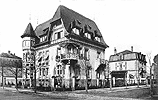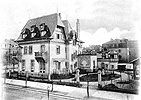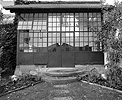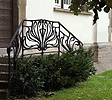Finished in 1900 for Julius Boehm
(1), this imposing
villa is located at the corner of the well-famed allée de la Robertsau and rue Stoeber
(2). Its appearance, marked by regionalism, as attested by the roof
(3) and the wooden framework
(4) for the attic, does not ignore art nouveau as it was evidenced by the wrought iron balconies (especially that one at the corner, topped by a marquise). We could also admire on the front side a window in basket-handle arch, as well as several sculptures. The balconies were provided sculpted sidewalls and wrought iron. One of the of the walls on the
backyard was fitted with a décor done in trompe-l'-il. In the garden remains a
shelter (with sidewalls formerly in art nouveau style) which wall is fitted with a
wooden panel showing a whiplash décor. The
floor has been kept.
The villa was been altered in 1933 by an extension affecting the rear facade.
In 1963, strong alterations will affect again the villa. The corner tower will be pulled down, as well as the corner balcony.
Most of the decor will be sloped , as well as the nice janitor's house, which was in perfect stylistic agreement with the villa. Some of the wrought
iron balconies nevertheless remain, but not to their original location. The
gate is mostly preserved.
The Italian Government, now owner, endeavours in a near future, to restore the villa.







 (1) Daniel Guillaume Jules Boehm (10/5/1873, Bordeaux - 8/6/1948, Paris) is recorded as a brewer. His first name has been germanized, it then is quoted in the telephone book as Julius Boehm. He works as a authorized representative at the Gruber brewery from 1890 to 1901. He married in 1904 with Francine Lobstein in Paris, and gets a daughter in 1905. The villa is sold in 1912.
(1) Daniel Guillaume Jules Boehm (10/5/1873, Bordeaux - 8/6/1948, Paris) is recorded as a brewer. His first name has been germanized, it then is quoted in the telephone book as Julius Boehm. He works as a authorized representative at the Gruber brewery from 1890 to 1901. He married in 1904 with Francine Lobstein in Paris, and gets a daughter in 1905. The villa is sold in 1912.
(2) Gustave Krafft let build his own house at n°6 in the same street.
(3) Covered with flat tiles strong slope croups, and overlapping edges, all typical from Alsatian architecture.
(4) Elements that we will found again with for the villa of Prof. Madelung, at 9, rue Schiller (Berninger & Krafft, 1901-04).







